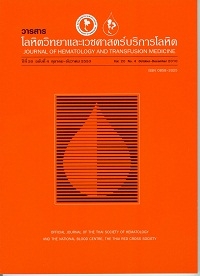แอนติบอดีต่อเชื้อไข้หวัดใหญ่สายพันธุ์ใหม่ (H1N1) 2009 ในผู้บริจาคโลหิต ช่วงปีระบาดปี พ.ศ. 2552
Keywords:
เชื้อไข้หวัดใหญ่สายพันธุ์ใหม่ (H1N1) 2009, ผู้บริจาคโลหิต, ระลอกแรก, วิธียับยั้งการเกาะกลุ่มของเม็ดเลือดแดง, Pandemic (H1N1) 2009, Blood donor, First wave, Hemagglutination Inhibition (HI) assayAbstract
บทคัดย่อ
วัตถุประสงค์ : ไข้หวัดใหญ่สายพันธุ์ใหม่ (H1N1) 2009 แพร่เข้ามาในประเทศไทยตั้งแต่เดือนพฤษภาคม ปี พ.ศ. 2552 การศึกษานี้ต้องการทราบสถานภาพการติดเชื้อไวรัสนี้ในผู้บริจาคโลหิตช่วงระหว่างปีของการระบาดระลอกแรก โดยติดตามจากจำนวนคนที่สร้างแอนติบอดีตอบสนอง วัสดุและวิธีการ : พลาสมาผู้บริจาคโลหิตที่มาบริจาคโลหิตที่ศูนย์บริการโลหิตแห่งชาติ สภากาชาดไทยในเดือนกันยายน ปี พ.ศ. 2552 จำนวน 100 ราย เป็นเพศหญิง 56 คนและเพศชาย 44 คน อายุตั้งแต่ 17-60 ปี แบ่งตามอายุ <20 ปี (2 คน), 20-39 ปี (60 คน) และ 40-60 ปี (38 คน) ซึ่งมาจากหลายอาชีพตั้งแต่พนักงานบริษัท ประชากรทั่วไป ข้าราชการ นักศึกษา และพระภิกษุ โดยทำการตรวจหาแอนติบอดี (Ab) ต่อเชื้อไข้หวัดใหญ่สายพันธุ์ใหม่ A/Thailand/104/2009 (H1N1) ด้วยวิธียับยั้งการเกาะกลุ่มของเม็ดเลือดแดงห่าน (Hemagglutination inhibition, HI) ผลการศึกษา : การทดสอบนี้พบผู้มีแอนติบอดีเพียงร้อยละ 20 (HI Ab > 10) เมื่ออาศัยเกณฑ์ไตเตอร์ของ HI Ab > 40 ที่บ่งชี้การติดเชื้อไข้หวัดใหญ่สายพันธุ์ใหม่ พบว่ากลุ่มผู้บริจาคโลหิตน่าจะติดเชื้อร้อยละ 7 และพบได้ในทุกอาชีพ โดยไม่ทราบว่ามีหรือไม่มีอาการ สรุป : ในช่วงปีที่มีการระบาดในระลอกแรก จากการศึกษาแอนติบอดีตอบสนองต่อเชื้อไข้หวัดใหญ่สายพันธ์ใหม่พบว่าในกลุ่มผู้บริจาคโลหิตน่าจะมีการติดเชื้อประมาณร้อยละ 7 และทุกอาชีพพบการติดเชื้อได้
Key Words : เชื้อไข้หวัดใหญ่สายพันธุ์ใหม่ (H1N1) 2009, ผู้บริจาคโลหิต, ระลอกแรก , วิธียับยั้งการเกาะกลุ่มของเม็ดเลือดแดง
Abstract
Objective : The 2009 pandemic influenza illness has been introduced into Thailand in May since 2009. Herein, we would like to determine the situation of this infection in blood donor during the first pandemic wave during the outbreak by the presence of antibody response. Material and method : A total of 100 plasma donation from blood donors at National Blood Center, Thai Red Cross were obtained from 56 females and 44 males in September 2009. Age range of these random donors (age range 17-60 years) was classified into 3 groups: <20 years (n=2), 20-39 years (n=60) and 40-60 years (n=8). Subjects were comprised of company employee, government officer, student and monk groups. Serological response to pandemic (H1N1) 2009 was performed by Hemagglutination Inhibition (HI) assay using goose erythrocytes. Result : In this study, it was demonstrated that only 20% of donor group had antibody (HI Ab > 10). According to the HI Ab titer at > 40 as criteria of this virus infection, the attack rate of infection was 7% and the infection was found in all occupation with unknown of the symptom situation. Conclusion : During the first pandemic wave of pandemic (H1N1) 2009, 7% of donor group in this study were infected as supported by HI antibody response and all occupation has been infected.
Key Words : Pandemic (H1N1) 2009, Blood donor, First wave, Hemagglutination Inhibition (HI) assay


